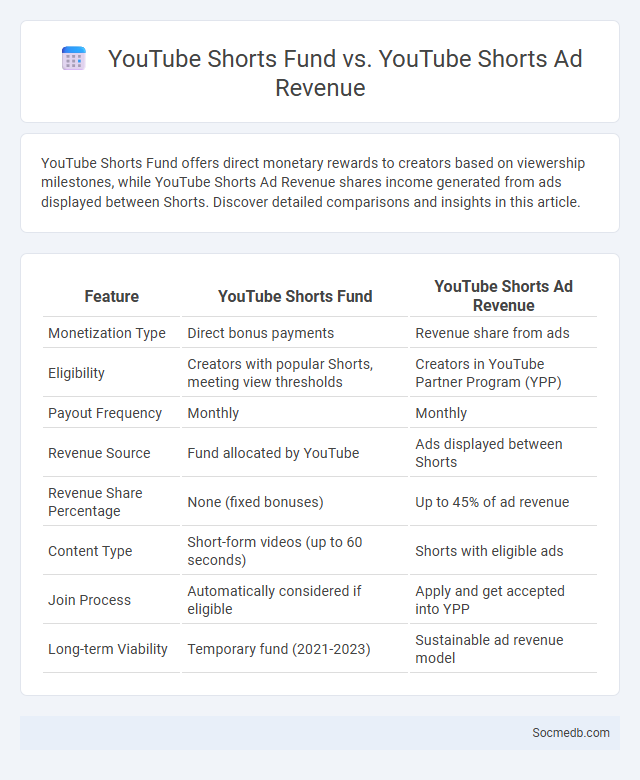
Photo illustration: YouTube Shorts Fund vs YouTube Shorts Ad Revenue
YouTube Shorts Fund offers direct monetary rewards to creators based on viewership milestones, while YouTube Shorts Ad Revenue shares income generated from ads displayed between Shorts. Discover detailed comparisons and insights in this article.
Table of Comparison
| Feature | YouTube Shorts Fund | YouTube Shorts Ad Revenue |
|---|---|---|
| Monetization Type | Direct bonus payments | Revenue share from ads |
| Eligibility | Creators with popular Shorts, meeting view thresholds | Creators in YouTube Partner Program (YPP) |
| Payout Frequency | Monthly | Monthly |
| Revenue Source | Fund allocated by YouTube | Ads displayed between Shorts |
| Revenue Share Percentage | None (fixed bonuses) | Up to 45% of ad revenue |
| Content Type | Short-form videos (up to 60 seconds) | Shorts with eligible ads |
| Join Process | Automatically considered if eligible | Apply and get accepted into YPP |
| Long-term Viability | Temporary fund (2021-2023) | Sustainable ad revenue model |
Introduction to YouTube Monetization Options
YouTube monetization offers multiple revenue streams including AdSense ads, channel memberships, and Super Chat during live streams. Content creators can also earn through YouTube Premium revenue and merchandise shelf integrations. Understanding these options helps maximize income potential and grow sustainable digital businesses.
What is the YouTube Shorts Fund?
The YouTube Shorts Fund is a $100 million global initiative launched by YouTube to reward creators for making original short-form videos on the Shorts platform. This fund pays eligible creators monthly bonuses based on the engagement and views their Shorts receive, helping to monetize content without traditional ad revenue. YouTube aims to support creators and encourage innovative, engaging short video formats through this dedicated financial incentive.
How YouTube Shorts Fund Rewards Creators
YouTube Shorts Fund distributes millions annually to creators based on the performance and engagement of their short-form videos. The program rewards creators whose Shorts achieve high viewership and viewer interaction, incentivizing content innovation and consistency. You can benefit from this fund by producing popular, engaging Shorts that meet YouTube's eligibility criteria and guidelines.
Understanding YouTube Shorts Ad Revenue
YouTube Shorts ad revenue is generated through short-form video content, offering creators new monetization opportunities by capitalizing on high viewer engagement. Your earnings from Shorts ads depend on factors like viewer demographics, content niche, and ad impressions within the Shorts feed. Optimizing video length, hashtags, and audience interaction increases your potential to maximize revenue from YouTube Shorts.
Eligibility Criteria for YouTube Shorts Ad Revenue
YouTube Shorts ad revenue eligibility requires creators to join the YouTube Partner Program, have at least 1,000 subscribers, and accumulate 10 million valid public Shorts views in the last 90 days. Creators must comply with YouTube monetization policies and reside in a country where the program is available. Meeting these criteria enables access to monetization features specifically designed for Shorts content.
Overview of Traditional YouTube Ad Revenue
Traditional YouTube ad revenue mainly comes from Google Ads, which allows brands to place ads in various formats such as skippable video ads, non-skippable video ads, and display ads. Advertisers pay based on cost-per-click (CPC) or cost-per-impression (CPM), with average CPM rates varying widely by niche and audience demographics, often ranging between $2 to $10. YouTubers typically receive 55% of the ad revenue generated, while YouTube retains 45%, making content engagement and viewer retention critical factors for maximizing earnings.
Key Differences: Shorts Fund vs Shorts Ad Revenue
YouTube Shorts Fund offers creators fixed monthly payments based on video performance and audience engagement, independent of ad revenue. Shorts Ad Revenue sharing allocates a percentage of ad earnings from ads displayed between Shorts videos directly to creators. The Fund incentivizes growth and content creation, while Ad Revenue sharing ties creator income to actual advertisement monetization metrics.
Key Differences: Shorts Ad Revenue vs Traditional Ad Revenue
Shorts ad revenue primarily relies on high engagement metrics and short-form content consumption patterns, generating income through brief, impactful ads tailored for quick viewer attention. Traditional ad revenue depends on longer, more detailed advertisements integrated into standard-length videos, with earnings driven by extended watch time and in-depth audience targeting. The monetization models differ significantly, with Shorts emphasizing volume and rapid views, while traditional platforms focus on sustained viewer interest and comprehensive brand messaging.
Pros and Cons of Each Monetization Method
Social media monetization offers methods like sponsored content, affiliate marketing, and ad revenue, each with distinct pros and cons. Sponsored content provides direct brand partnerships but may alienate your audience if overused, while affiliate marketing can generate passive income yet depends heavily on audience trust and product relevance. Ad revenue offers consistent earnings through platforms like YouTube or Facebook but often requires high traffic volumes and may lead to intrusive viewer experiences.
Which Monetization Strategy is Best for Creators?
Subscription-based models often outperform ad revenue and sponsorships by providing creators with consistent, recurring income. Platforms like Patreon and OnlyFans enable direct fan support, increasing financial stability and fostering community engagement. Diversifying income through merchandise sales and exclusive content further enhances earning potential and reduces reliance on fluctuating algorithms.
 socmedb.com
socmedb.com